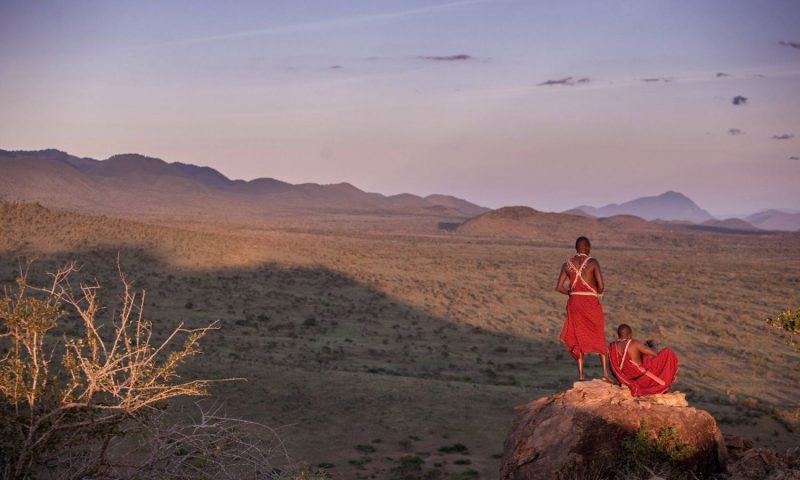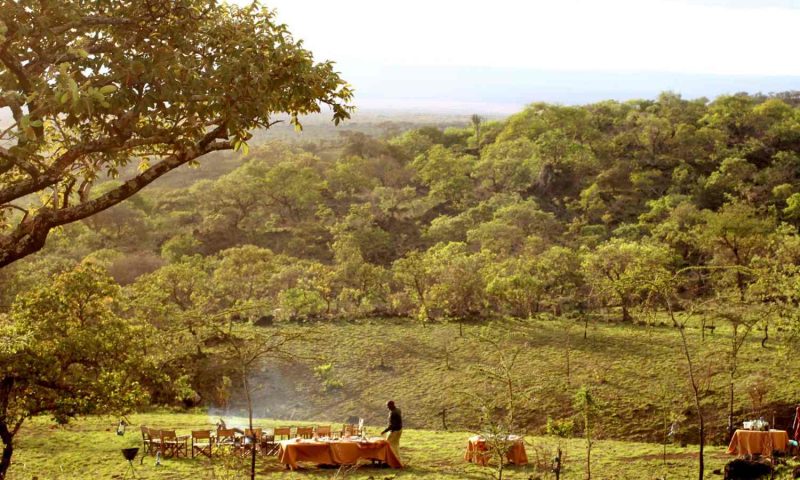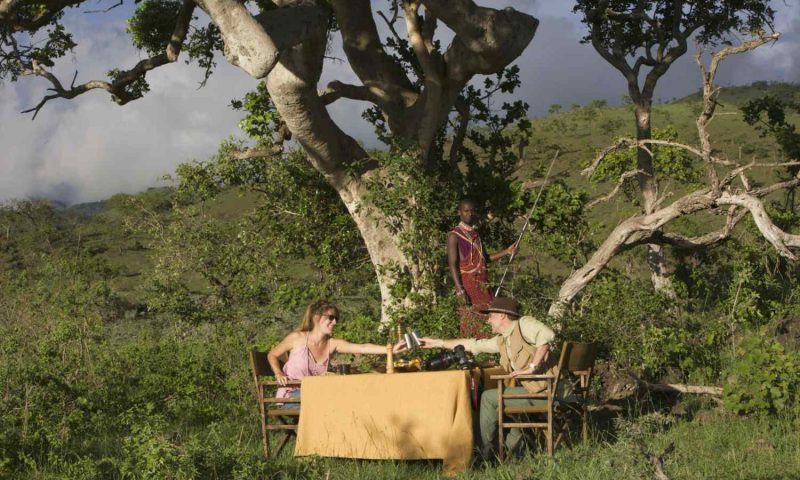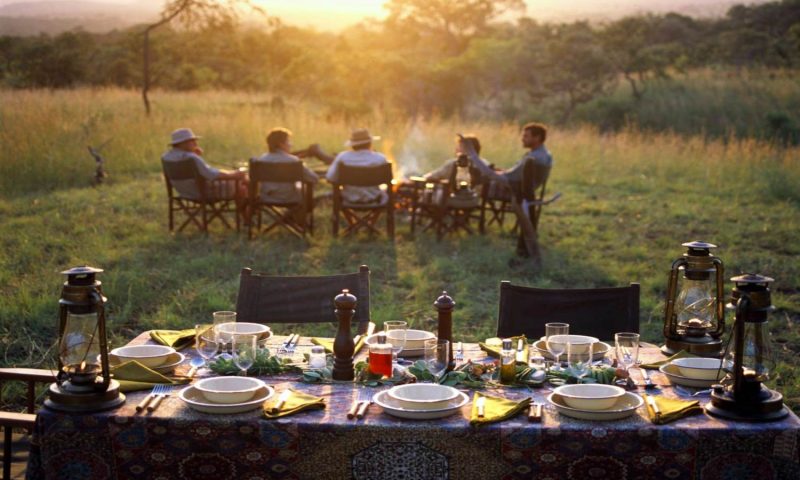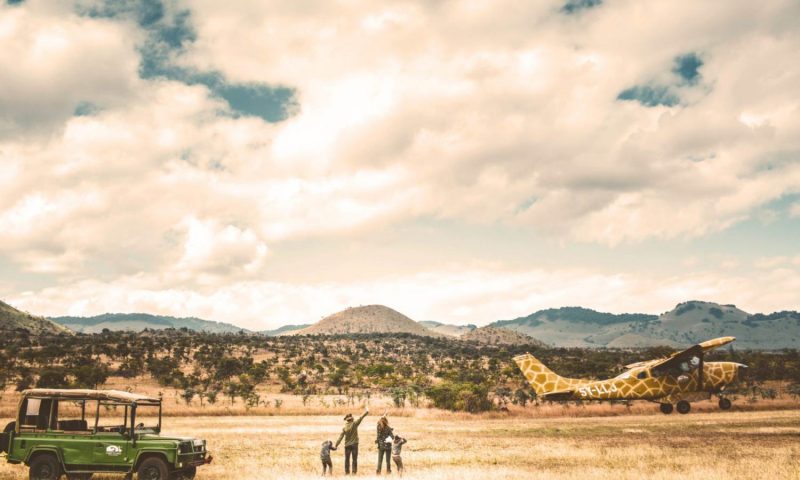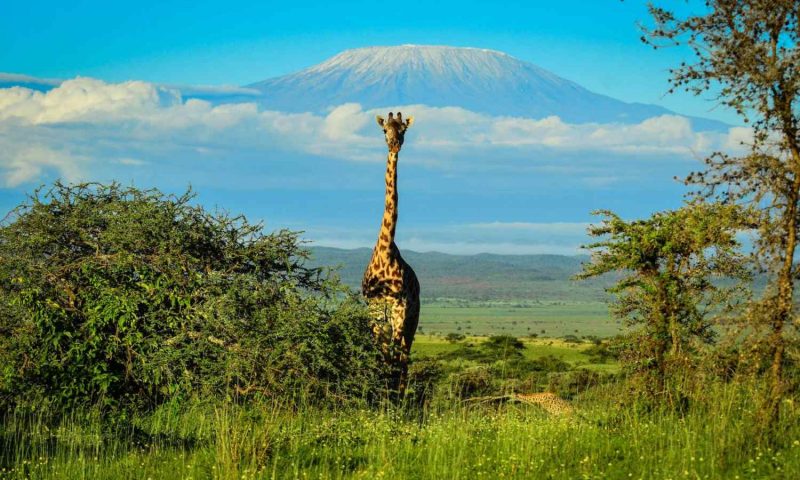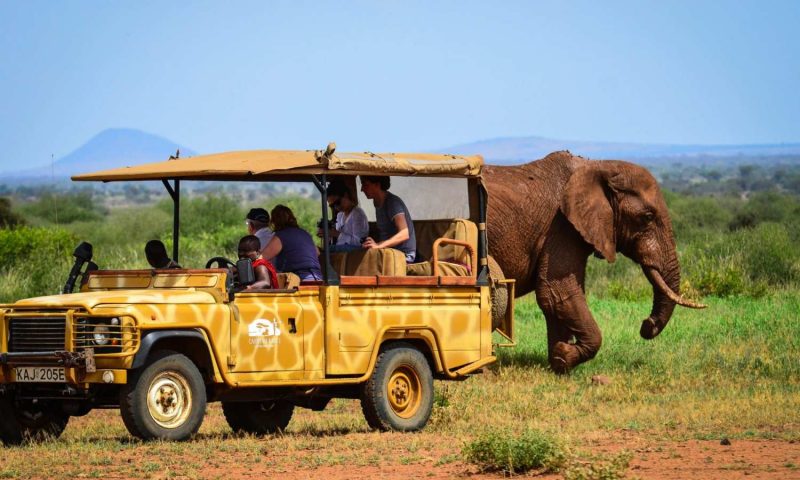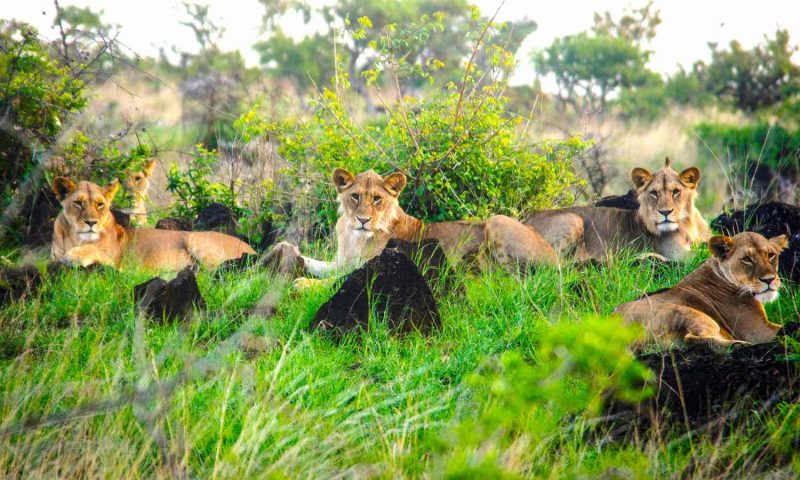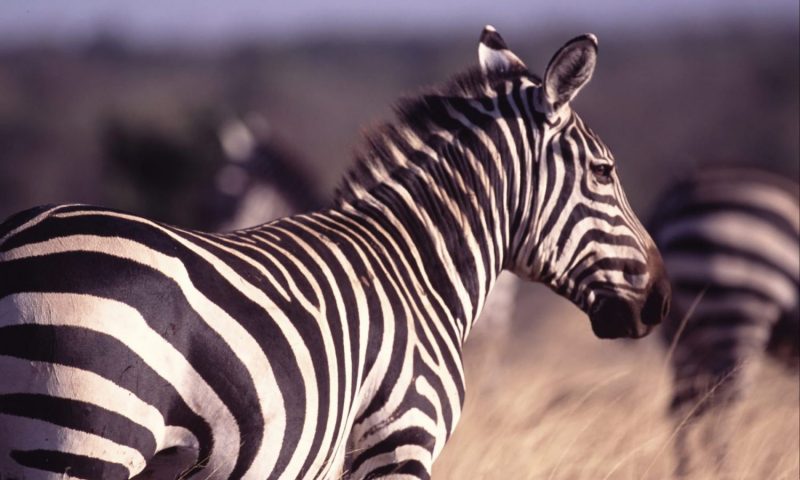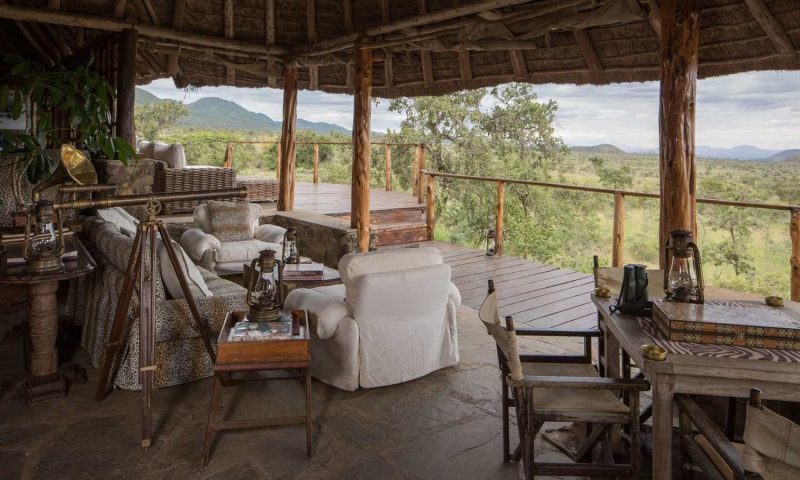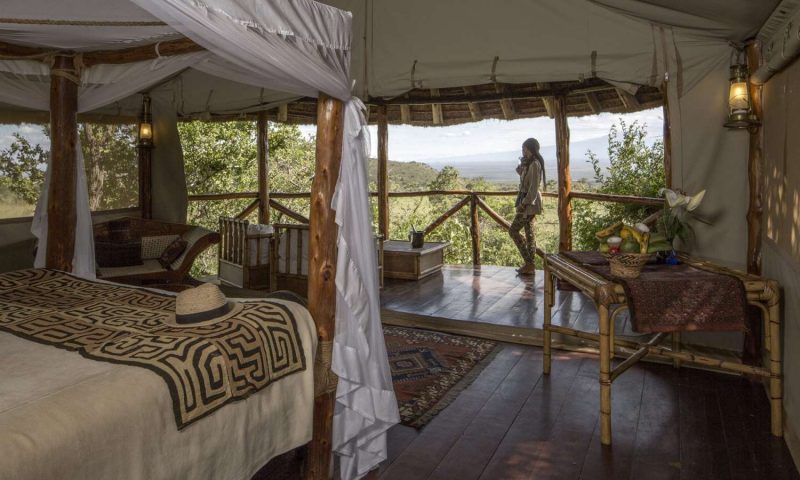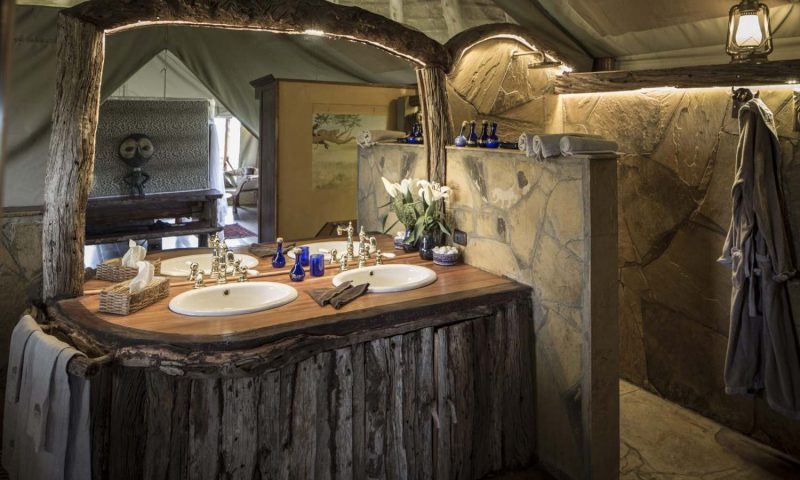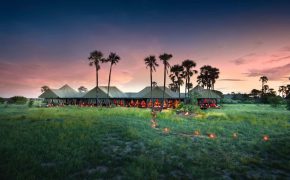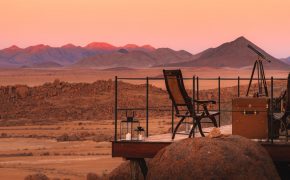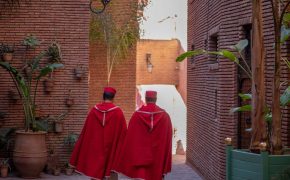Campi ya Kanzi is widely recognized as one of the most inspiring and eco-friendly safari experiences in Africa.
Situated at the foot of the legendary Chyulu Hills, Ernest Hemingway’s “Green Hills of Africa” it is a luxury camp offering an incomparable combination of 5-star luxury, first class wilderness adventure, amazing wildlife, and authentic immersion in Maasai culture. This is truly the ultimate African safari.
This luxury lodge has been built in partnership with the Maasai community of the 283,000-acre Kuku Group Ranch.
Campi ya Kanzi has a unique commitment to community development and environmental sustainability: we are leaders in real ecotourism, engaging the local Maasai in benefiting from the wilderness with thriving wildlife, we are 100% solar and carbon neutral.
We offer luxurious comfort, thrilling outdoor adventure, memorable wildlife encounters, and authentic connection to the Maasai people. In front of Kilimanjaro, with a Maasai warrior taking you on safari, among elephants and lions, you will experience your dream African adventure.
History of Campi Ya Kanzi
It really began in the ’60s, when a 4-year-old Luca wanted to impress his dad and slept all alone in a tent in the family Italian vineyards.
He wanted to prove he could go on safari! Luca came to Kuku Group Ranch, the Maasai 283,000 acres reservation where Campi ya Kanzi is, in 1975 when he was just 11 years old. 20 years later he came back with his then-girlfriend; now wife, Antonella.
Together they engaged the local Maasai landlords and formed a unique partnership, creating the community-owned lodge Campi ya Kanzi.
More than 20 years and 3 kids (Lucrezia, born 2002, Jacopo born 2007, and Lorenzo, born 2009) later, this is their home. Together with amazing Maasai who with them built the lodge, like Parashi, Matasha, Samson, Pashiet, Lengou…
Hemingway & Simba Tented Suites
The classic safari experience under canvas, with the luxury of a comfortable bed and a full ensuite bathroom. Each of the luxury tented suites, Hemingway and Simba, provide two of the best views of our watering hole and of the hills surrounding the camp.
A perfect oasis to enjoy the vast wildlife such as zebras, giraffes, and lions that visit our watering hole while you enjoy a cup of tea and bitings on your private porch. Great for honeymooners, couples or any guest that would like to experience a home away from home while enjoying the wilderness right at their fingertips!
Luxury Tented Cottage
The classic safari experience under canvas, with the luxury of a comfortable bed (4 tented cottages have twins, 2 have a king size bed) and a full ensuite bathroom.
Each of the six luxury tented cottages are named after the beautiful view of the specific hills that they face: Chyulu, Longitok, Elenyo Waite, Kilimanjaro, Oldonyo Oibor and Ololorami.
You can enjoy a view of the vast wildlife that visits our watering hole as well while you enjoy a cup of tea and bitings on your private porch. Make yourself at home in the midst of stunning wilderness! The luxury cottages can accommodate a child in a safari cot. Two of the cottages are close to each other and ideal of a family.
5 Night Safari with us!
If you wonder how a safari would unfold, here is an example of how a safari of 5 nights with us would be, exploring the Chyulu Hills, Amboseli and Tsavo National Parks!
Day 1: Leave Nairobi Wilson in the late morning, for a 1-hour flight to Campi ya Kanzi. The airstrip is 10-minute game drive from the lodge. Campi ya Kanzi staff, with Claudia and Luca, will be welcoming you and give you a briefing of where we are and what can be arranged for you.
Lunch will be at cozy at Tembo House, the heart of the lodge. In the afternoon, you can do a game walk of about 90 minutes, with a local Maasai guide, who will take you to Longido, a magnificent look-out hill, more than 500,000,000 (yes 500 hundred million!) years old. Then a dusk game drive back to the lodge, for a 5-course candlelight Italian dinner.
Day 2: After tea or coffee brought by a Maasai attendant to your tent, enjoy a game drive in Kanzi Conservancy, where lions, cheetah, buffaloes, giraffes, zebras, impalas, hartebeest roam plentifully.
Then you could enjoy a game walk, or experience the special pleasure of riding a horse next to zebras and giraffes. Breakfast could be served in the bush or at Tembo House. Another possibility would be flying to Amboseli National Park, where the elephant experience is simply superb.
The afternoon could be spent relaxing at the swimming pool, or enjoying a massage, or with a beautiful game drive to Okoikuma, a hill dominating the plains from Mt. Kilimanjaro. Then a dusk game drive back to the lodge.
Day 3: After breakfast al fresco, under a huge fig free outside of Tembo House, a game drive will take you up into the Chyulu hills, where you could enjoy a stroll or a hike in the Cloud Forest. The forest is spectacular, with an immense diversity of trees, shrubs, flowers, birds, and wildlife.
You will return to Campi ya Kanzi for lunch and the afternoon could be spent with a lovely walk to a special place, which could be reached also by horse-back riding or with a game drive. We will surprise you with an unforgettable dinner!
Day 4: You will leave Campi ya Kanzi, heading to Chyulu Club, in Tsavo. This morning could have many different choices of activities: a scenic flight to either Kilimanjaro or over Tsavo, a game drive or a cultural immersion in the Maasai village, with the option to visit Maasai Wilderness Conservation Trust HQ, to learn about its programs.
Lunch will be al fresco, at the Acacia Cafè of Chyulu Club, which is the first lodge in Africa to not just be carbon neutral, but carbon negative, with an afforestation program.
Afternoon will be spent with a lovely game drive in the marvelous Olpusare Conservancy, where we often see elephant, buffalo, wildebeest, lesser kudu, oryx, eland, cheetah, leopard, and lion. Dinner under the stars in front of the spring, at Chyulu Club.
Day 5: We will spend this day in the endless wilderness of Tsavo, visiting the splendid Mzima spring, where hippo, vervet and Syke’s monkeys are the landlords. During this game drive is possible to see rhino, as well as very many species of mammals and birds.
Our record is 33 different species of mammals during this trip! Try to beat it! The geology of the landscape is mindboggling: from rocks more than a billion years old, to Shaitani – a lava flow just a couple of centuries old. Dinner at Chyulu Club will have a special Maasai farewell.
Day 6: Time to say goodbye to your new home in Africa: after breakfast, we will fly you to either Nairobi or to your next safari destination.
Air Safari
In a land where roads are scarce and wilderness is vast, aviation has opened infinite possibilities to explore and experience the African continent. Traditional safaris on land offer great opportunities for game viewing, air safaris expand the adventure upward into limitless African skies.
Travelers can soar over the Okavango Delta, skim the Skeleton Coast, and veer through the gorges of Victoria Falls. Imagine the Great Migration from a bird’s eye view, with hundreds of thousands of wildebeest sprawling across the plains. Here is the itinerary of our latest Kenya/Tanzania air safari:
- Start from Nairobi with a scenic flight to the Maasai Mara.
- Fly into Tanzania to continue following the Great Migration, in the Serengeti.
- Enjoy a spectacular flight to the Ngorongoro Crater, landing on its rim.
- Fly South to Ruaha and explore that diverse National Park
- With a scenic flight over the Ruaha river fly to Zanzibar, for s stay on a private island, Mnemba.
- End this epic safari by flying back to Kenya and stay in the Chyulu Hills and Tsavo.
- If you want to explore Africa we can tailor-make an itinerary that will bring you from Kenya to Tanzania, for the chimpanzee, Rwanda for the gorilla, Zambia for Victoria Falls, Zimbabwe for the Lower Zambezi, Botswana for the Okavango, ending with the spectacular wilderness of Namibia.
These air safaris are organized and hosted by Luca Belpietro, founder of Campi ya Kanzi and the Maasai Wilderness Conservation Trust. To see Africa as eagles do is a truly unparalleled experience!
Conservation
Why should conservation be of any concern or interest to you? After all, a safari is a holiday and you want to have a peaceful moment of distraction and relaxation, when away from work and home…
Conservation should be of your concern for a simple reason: if you want the African wilderness to survive and be there for your next safari, and certainly for the safari your children will want to enjoy, you better think about it. And do something about it.
Chose us for your safari and you will protect African wilderness, wildlife, and the Maasai culture. The lodge’s founding principle is to prove to the Maasai landlords that wilderness with thriving wildlife is worth protecting because it pays economic dividends.
Tourism is a means to an end: making sure that the Maasai wilderness, cultural, and wildlife heritage are protected, for generations to come.
A stay at Campi ya Kanzi translates into a $116 conservation fee for the benefit Maasai Wilderness Conservation Trust. Campi ya Kanzi is owned by the Trust, and all the lodges proceeds are invested in conservation.
The conservation fees are earmarked for Wildlife Pays, a compensation program where all losses caused by wildlife to the Maasai livestock are reimbursed to the community if predators are not killed.
As a result, this is one of the few places in Africa where the lion population is not only thriving but increasing significantly. MWCT has been successful in securing Payment for Ecosystem Services that enable it to employ over 400 Kenyans, offering education, health, and conservation services to the Maasai community.
The Trust
The Maasai Wilderness Conservation Trust (MWCT) works to protect the legendary ecosystems and astounding biodiversity of East Africa through conservation that directly benefits local Maasai communities.
Founded in 2,000 by Luca and Antonella, the Trust is now chaired by UNEP Champion of the Earth, Samson Parashina, and its President is UN Goodwill Ambassador for Biodiversity, Edward Norton. UNDP celebrated MWCT by awarding it the Equator Prize, at Rio+20, in 2012.
The world increasingly relies on many traditional communities like the Maasai to protect the ecological treasures that exist within the land that they own. But the incredible wilderness and wildlife of Africa’s grasslands and the famous culture of the Maasai people both face daunting threats to their long-term survival.
The fate of both rests with the Maasai themselves as they work to figure out how to benefit from their incredible natural resources while preserving them.
That’s what MWCT is all about—a pioneering partnership between professional conservationists and dynamic young Maasai leaders to show that the Maasai community can thrive, not just survive, by managing their ecosystem wisely.
The Maasai communities of this area own all of the land between the protected National Parks and within their land lie critical wildlife migration corridors and habitat reserves, forests that are carbon sinks, and rivers and springs that supply the fresh water not only to this ecosystem but to more than seven million people in Kenya, including the second-largest city.
MWCT funds and operates Education, Health, and Conservation programs that promote sustainable economic benefits from conserving this ecosystem.
Maasai people
Maasai (not Masai or Massai) is the correct spelling of this noble tribe: it means people speaking maa. Masai was the incorrect spelling of the British settlers and has remained in current use. Kenya recognizes over forty tribes of native people.
The Maasai were the dominating tribe at beginning of the 20th century. They are one of the very few tribes who have retained most of their traditions, lifestyle, and lore. The Maasai have always been special. Their bright red robes set them apart visually. Spear in hand, they are calm and courageous regardless of the danger.
The armed British troops who drove the Maasai from their lands in the early 20th century had great respect for these fearless tribesmen. Up until recently, the only way for a Maasai boy to achieve warrior status was to single-handedly kill a lion with his spear.
By choosing Chyulu Wilderness Camp for your Kenya safari, you will not only enjoy a unique and pristine wilderness and amazing wildlife, but you’ll actively protect them and help the Maasai community.
When you see a Maasai for the first time, you will likely agree with what Karen Blixen (Isak Dinesen) wrote about her experience in East Africa in her book Out of Africa:
“A Maasai warrior is a fine sight. Those young men have, to the utmost extent, that particular form of intelligence which we call chic; daring and wildly fantastical as they seem, they are still unswervingly true to their own nature, and to an immanent ideal. Their style is not an assumed manner, nor an imitation of a foreign perfection; it has grown from the inside, and is an expression of the race and its history, and their weapons and finery are as much a part of their being as are a stag’s antlers.”
A bit of Maasai tribe history
In common with the wildlife with which they co-exist, the Maasai need a lot of land. Unlike many other tribes in Kenya, the Maasai are semi-nomadic and pastoral: they live by herding cattle and goats.
The Maasai’s god is Engai. They believe he created them, gave them all the cattle in the world, and later made other human beings. The Maasai refer to the neighboring tribes of farmers and hunter-gatherers as “Ndorobo,” meaning poor folk.
Maasai measure wealth by the number of cattle, so people without cattle are considered poor. Maasai did not have villages with permanent buildings. Instead, they constructed an “enkang” (corral) for a group of families. The “enkang” is a circle of huts, one per family, enclosed by a circular fence of thorn bushes.
The woman of each household constructs the hut from cattle dung and clay. Periodically, the groups would abandon their “enkang” and construct a new one in an area with better water and grazing. This old way of nomadism is almost gone, there is no more land where to roam to.
“Laibon” can be roughly translated from Maa in “witch doctor;” a better word would be “vision seeker”. Laiboni were spiritual leaders, with an ability to divine the future.
Mbatiany in the last part of the 19th century had a tremendous vision: a metal snake was coming up from the Coast, with people whose skin was the color of flamingos. If it was coming things would have never been the same again for the Maasai.
He wanted to stop the snake, but the warriors had no fear and told him to let it come. He was unfortunately right. The train (the metal snake he dreamt of) arrived in the last decade of 19th Century, just a few years after Mbatiany death.
Through forcing his two sons, Olonana (aka Lenana) and Senteu, in land agreements, the colonial administration deprived the Maasai of their best land. The Maasai have not fared well in modern Africa. Until the European settlers arrived, fierce Maasai tribes occupied the most fertile lands.
The Maasai struggled to preserve their territory, but their spears were no match for armed British troops, and their lawyers never had a fair chance in British courtrooms. In 1904, the Maasai signed the first agreement, losing the best of their land to the European settlers.
Seven years later, in 1911, a very controversial agreement was signed by a small group of Maasai, where their best Northern land (Laikipia) was given up to white settlers.
Surely they did not fully understand what the consequences of such a treaty were, and anyway the signatories did not represent the entire tribe. With these two treaties, the Maasai lost about two-thirds of their lands and were relocated to less fertile parts of Kenya and Tanzania.
Which future for Maasai tribe?
Other tribes of Kenya have adapted more readily to the “progress” of modern times. In contrast, the Maasai have persisted in their traditional ways, so as Kenya takes more land for growing tribes and agriculture, they suffer.
One positive trend for the Maasai in recent years has been the development of a specific form of eco-tourism. Although other tribes in Kenya regard wildlife as food or a menace to their crops, the Maasai have proven to be able to co-exist with wildlife.
But less land for an ever-growing Kenyan population means less land for the Maasai, their livestock, and wildlife. More and more, a lion will take a cow or some goats and get killed in retaliation.
While in the past the retaliatory killing by poisoning was unheard of, and lions were bravely hunted on foot by warriors simply armed with spears, nowadays poisoning has become a common and very effective method. Carcasses of livestock get poisoned with a chip pesticide, easily available in the market.
Lions are a disappearing species: their numbers plunged from an estimated population of 400,000 in mid-20th century, to as few as 23,000, with a range of 16,500-30,000, nearly 15 years ago (Bauer and Van Der Merwe 2004).
Maasai Wilderness Conservation Trust has pioneered a compensation program, reimbursing livestock killed by lions (and other predators). The program is called Wildlife Pays and it is supported by tourists’ conservation fees; it employs warriors as lions scout (more lions = more employment).
It is a cutting edge tourism Payment for Ecosystem Service, where tourists fund conservation, through their stay at Chyulu Wilderness Camp – totally sustainable and not depending on a single $ of philanthropy.
In the past, the Maasai and the wildlife simply lived together, in balance. If this could be re-established, by showing to the Maasai the economic value of the presence of wildlife in their land, the future of the land, of the wildlife, and of the Maasai people will be assured.
Environment
The human population in Kenya has increased tremendously in the last century, from just less than 1,300,000 in 1900 to nearly 44,000,000 in 2013, contributing to increasing in poverty and malnutrition. This unsustainable growth has put tremendous pressure on both the wilderness and wildlife.
Maasailand is, traditionally, land where human beings and wildlife have co-existed. In fact, the most visited National Parks in East Africa were Maasai land and are surrounded by Maasai land (Serengeti, Ngorongoro, Maasai Mara, Amboseli).
With 90% of the wildlife population of Amboseli National Park living in private Maasai land for part of the year, it is crucial that Maasai landlords earn economic benefits by protecting the wilderness status of their land.
That is our model of ecotourism: to make sure wilderness with thriving wildlife generates income for the Maasai landlords, to ensure the land where they have lived for hundreds of years, is protected for the generations to come.
Ultimately the protection of the environment, with its three aspects –wilderness, wildlife, and culture – is what we stand for. Your stay is carbon neutral through the Chyulu Hills REDD+ Carbon Project.
We also believe that the Maasai community needs an advocate. In 2000, Luca and his wife Antonella founded the Maasai Wilderness Conservation Trust (MWCT). The Trust has branches in Kenya, the United States, and Italy.
The President of the U.S. branch is Edward Norton: United Nations Ambassador for Biodiversity (appointed by UN Secretary-General Ban Ki Moon in 2010), founder of Crowdrise.com, member of the President Obama Committee for Arts and Humanities, and acclaimed filmmaker (actor, producer, writer, and/or director for more than 30 films; nominated for three Academy Awards for acting).
Sustainability
We believe true ecotourism should be based on the use of the best available technologies, have the lowest impact on the environment. That is what is guiding us in the day to day running of the Maasai Wilderness Conservation Trust.
We built everything by employing local Maasai people, teaching them how to build. We used only local materials, and not a single tree was cut. State of the art technology was applied for the use of renewable resources.
Electricity
We use photovoltaic panels to transform sunlight into electricity. This is stored in a bank of batteries. Three interfaced inverters transform the continuous current in alternate current, at 220V and 415V.
From the inverters, electricity runs through the entire camp, running all our appliances, from lamps to fridges. Nice to know that every electric need we have is generated by the sun, with absolutely no impact on the environment! Carbon footprint: zero!
Water
Water is our scarcest resource. We cropped our rains with a special water catchment system, of about 12,000 square meters (140,000 square ft.) and through our roof system (1,500 square meters, or 16,000 square ft.).
Water is then stored in PVC tanks and bladders, whose combined capacity is 1,600,000 liters (about 400,000 gallons). To our knowledge, we are the only lodge in East Africa whose water needs are entirely covered by rain cropping. Carbon footprint: zero!
We recycled both gray waters and black waters, with special filters imported from Europe. An anaerobic reaction assures the purity of water at the exit of the system. Final stage filtration is assured by a reed bed. Water is then used in ponds for the wildlife.
The use of specially imported ecological soaps assures the perfect chemical purity of the water. We utilized special low energy dishwashers and washing machines, to save on water consumption. Hot water is heated by a central solar system. Carbon footprint: zero. A water meter monitored the consumption of each unit.
Food
We avoid buying from unsustainable farming practices. In the kitchen, we cooked meals using special eco-friendly charcoal produced by the United Nations Environment Project.
It is made with coffee husks, a by-product of coffee farming. We compost our food scraps for use in our organic vegetable garden; we also have few chickens and few cows, for the organic production of eggs and milk.
Waste
Our staff is trained to assure the minimization of garbage production. All organic wastes are transformed into compost. The rest of the wastes are selected for recycling when viable, the remaining get incinerated in a special incinerator built on a UN recommendation.
Carbon Neutral
We are also carbon neutral. All carbon emissions related to running the lodge and transportation to and from the lodge, within Kenya, are offset toward the Chyulu REDD+ Carbon Project.
